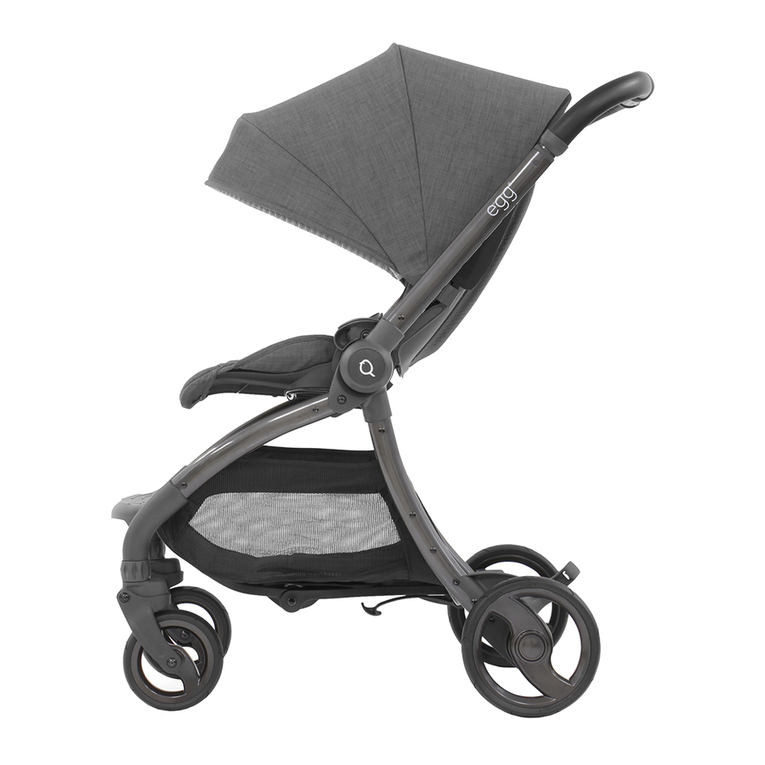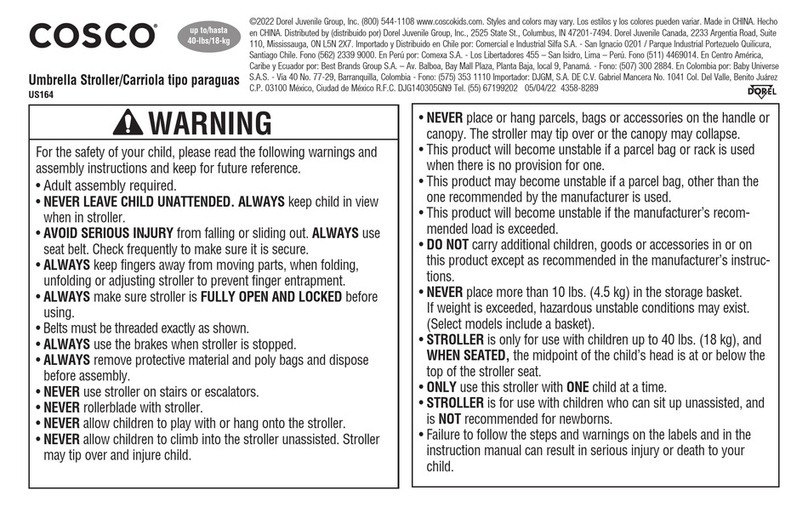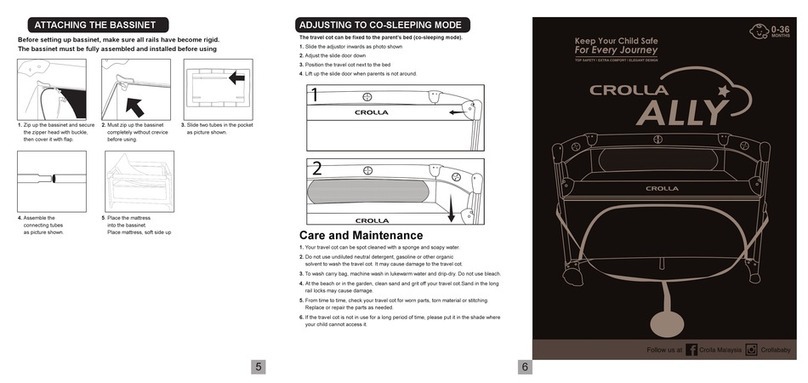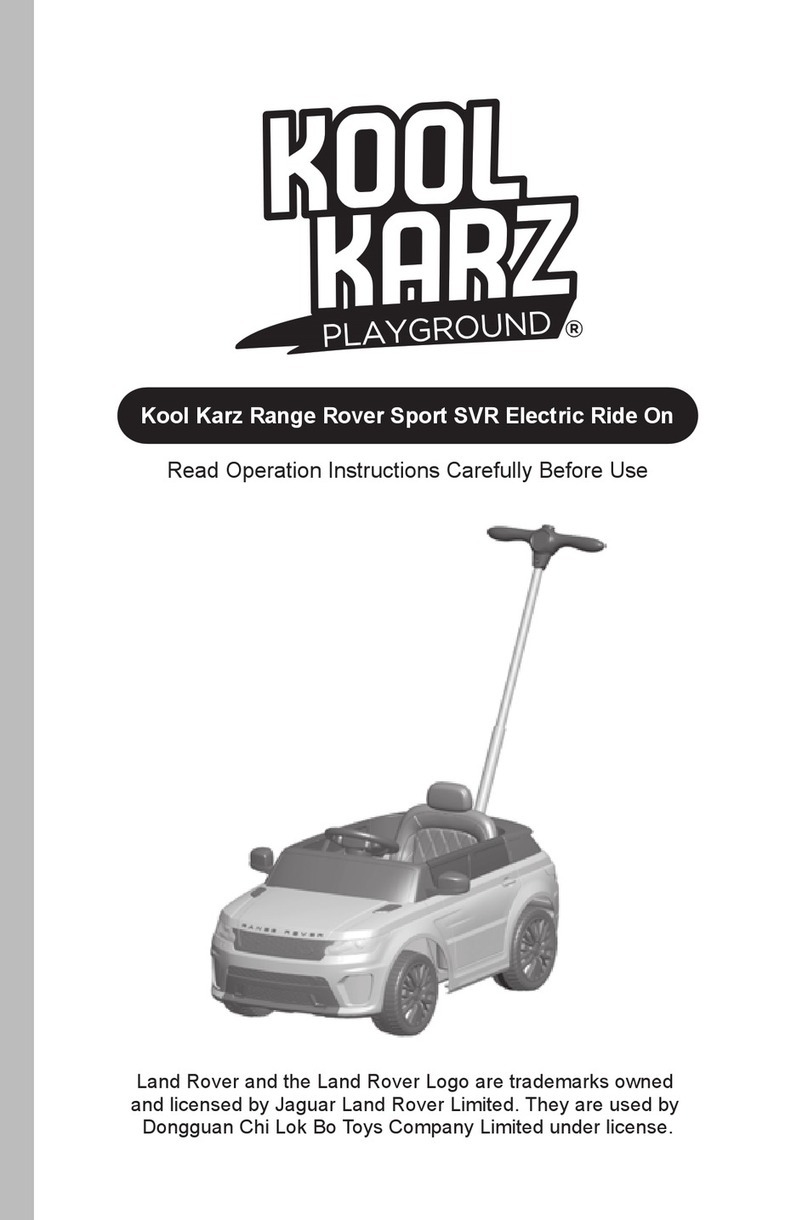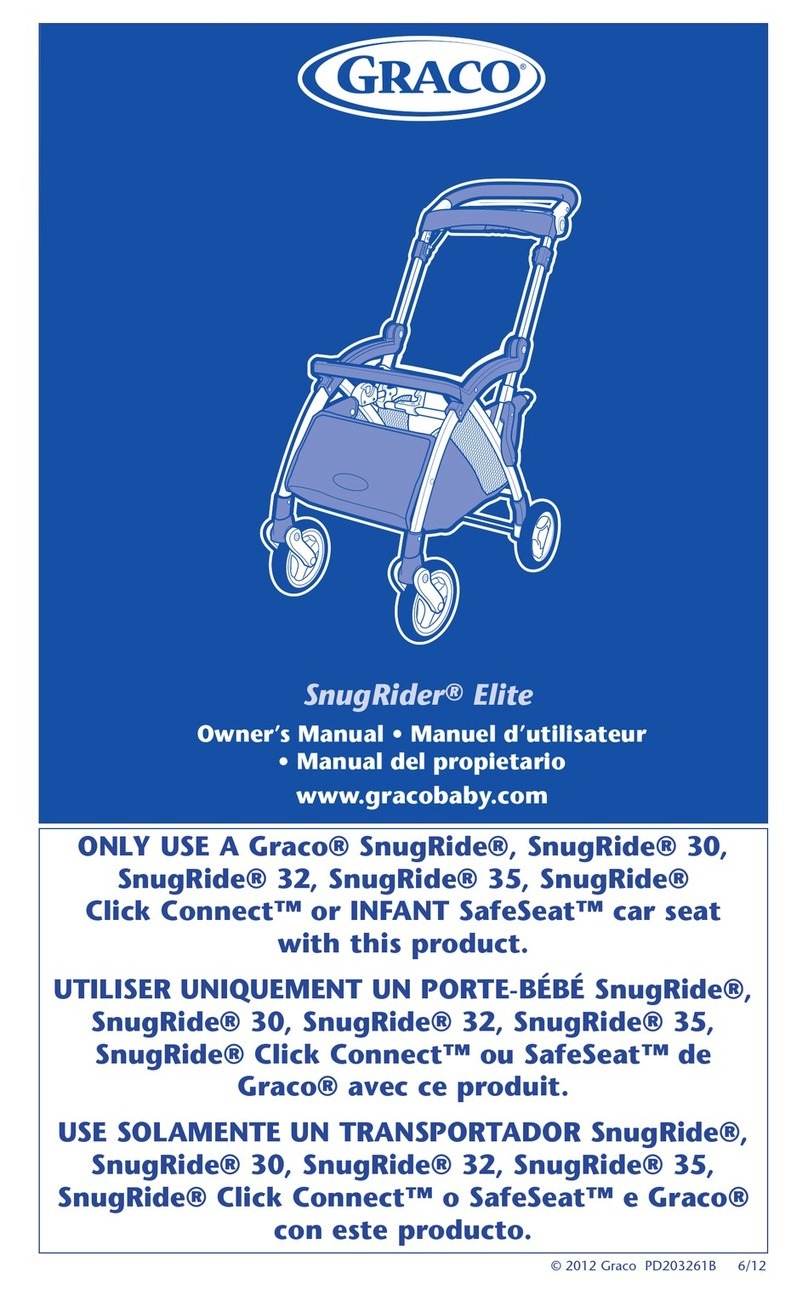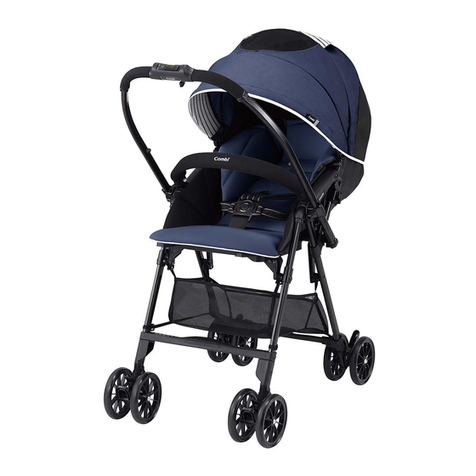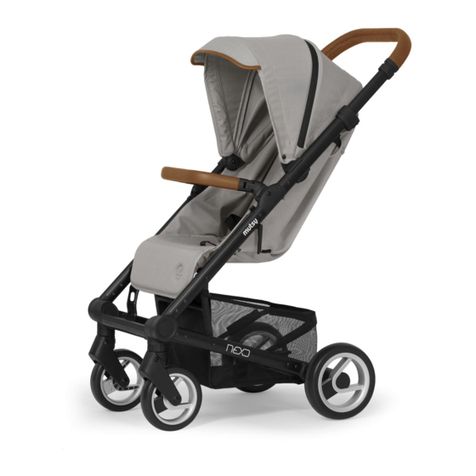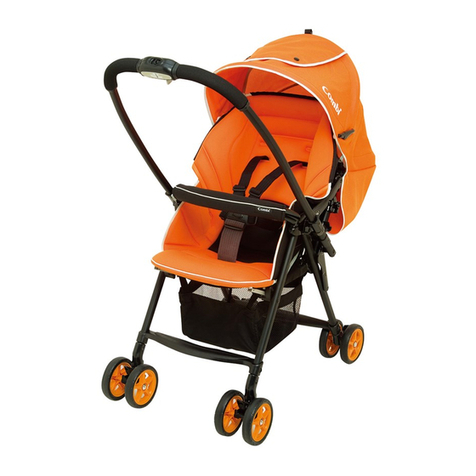Everest & Jennings EJ777-3 User manual

EJ777-3-INS-LAB-RevA15
© 2015 GF Health Products, Inc.
EJ777-3 Bariatric Transport Chair
Operation Manual
EJ777-3 Transport Chair user and attendant:
Read this manual before operating the Transport Chair.
Save this manual for future reference.
The most current version of this manual can be found online at
www.grahamfield.com.

EJ777-3-INS-LAB-RevA15 • EJ777-3 Bariatric Transport Chair 2
WARNING: EJ777-3 Transport Chair user and attendant: Do not operate the
transport chair without rst reading and understanding this manual. If you
do not understand the warnings, cautions, and instructions provided herein,
contact your healthcare professional, GF authorized distributor, or technical
representative before proceeding with the use of this product; otherwise
personal injury or damage to your transport chair could result.
CONTENTS
1 INTRODUCTION .........................................................................................................3
INTENDED USE ....................................................................................................3
STATEMENTS OF SIGNIFICANCE ......................................................................4
2 IMPORTANT SAFETY PRECAUTIONS .....................................................................5
EJ777-3 TRANSPORT CHAIR LABELS ..............................................................5
WARNINGS ...........................................................................................................5
3 OPERATION ...............................................................................................................7
COMPONENT IDENTIFICATION ..........................................................................7
HANDLING TIPS ...................................................................................................8
TO ATTENDANT ..............................................................................................8
BALANCE ........................................................................................................8
FOR ATTENDANT: TILTING ............................................................................9
RAMPS AND INCLINES ................................................................................10
CURBS AND STEPS .....................................................................................10
4 ADJUSTMENTS .......................................................................................................13
REAR WHEEL & CASTER .................................................................................13
CROSSBRACE ...................................................................................................13
ARM .....................................................................................................................14
FOOTREST—DETACHABLE, SWINGAWAY .....................................................15
ATTENDANT WHEEL LOCKS ...........................................................................16
5
TRANSPORTING THE EJ777-3 TRANSPORT CHAIR ........................................................17
PREPARING THE EJ777-3 FOR TRANSPORT .................................................17
6 MAINTENANCE ........................................................................................................19
7 TROUBLESHOOTING ..............................................................................................23
8 SPECIFICATIONS ....................................................................................................24
9 LIMITED WARRANTY ..............................................................................................25
10 INDEX .......................................................................................................................27
GF Health Products, Inc. is not responsible for typographical errors. All illustrations,
specications, packaging and warranties contained in this document are based on
the latest product information available at the time of printing. The most current
product information, including the most current revision of this manual, can be
found online at www.grahameld.com. Graham-Field is a registered trademark, and
Everest & Jennings and E&J are trademarks, of GF Health Products, Inc.

EJ777-3-INS-LAB-RevA15 • EJ777-3 Bariatric Transport Chair 3
1 INTRODUCTION
Thank you for choosing an Everest & Jennings product. We at GF Health Products,
Inc. (“Graham-Field”) wish to assure you of our continuing commitment to provide
innovation and quality in our products. Important safety, operating, and maintenance
instructions that warrant the attention of both user and attendant are included in
this operation manual. Read the entire manual carefully before operating your new
EJ777-3 Transport Chair, keep it handy for future reference, and refer to it as often as
necessary to help maintain good performance standards.
Consult your healthcare professional and GF authorized distributor for assistance
in developing and learning safe and effective techniques for performing your daily
activities according to your individual physical abilities and needs, and to make
certain that your Transport Chair is properly prescribed and adjusted for your use.
The safety precautions in this manual are general warnings intended to be used only
as basic guidelines. You may nd it necessary to develop your own methods for
safely solving frequently encountered challenges. Again, consult your professional
medical advisors for their recommendations about safety methods, and never
hesitate to ask for their assistance.
Your Transport Chair should receive frequent, regularly scheduled maintenance,
including an inspection of the mechanical parts, to ensure proper operation. Some
suggested inspection procedures, troubleshooting procedures, and adjustment
procedures are included in this manual. When it comes to service and repair,
remember that your GF authorized distributor knows your Transport Chair best.
The person performing adjustments on the EJ777-3 Transport Chair has the
responsibility of making certain that the user can safely operate the Transport Chair
with the adjustments selected. This person must evaluate the user's ability, weight,
physical condition, the environment in which the Transport Chair will be used, and
the terrain over which the Transport Chair will travel.
INTENDED USE
The EJ777-3 Transport Chair is a manual, folding, lightweight Transport Chair,
suitable for frequent users with a maximum weight capacity of 400 lb (182 kg) who
require a lightweight, portable Transport Chair, tted to their anatomy, without the
need of customization or alteration to the center of gravity. The EJ777-3 Transport
Chair is intended for indoor and/or outdoor use. The EJ777-3 Transport Chair is
intended to be propelled by an attendant at all times, who should remain behind the
Transport Chair when the user is being positioned or the Transport Chair is in use.

EJ777-3-INS-LAB-RevA15 • EJ777-3 Bariatric Transport Chair 4
STATEMENTS OF SIGNIFICANCE
Please note the following special statements, used throughout this manual, and their
signicance:
WARNING: Indicates a potential hazard situation or unsafe practice that, if not
avoided, could result in death or serious injury.
CAUTION: Indicates a potential hazard or unsafe practice that, if not avoided,
could result in minor or moderate personal injury.
sNOTICE: Indicates a potential hazard or unsafe practice that, if not avoided,
could result in product or property damage.
Info: Provides application recommendations or other useful information to
ensure that you get the most from your product.

EJ777-3-INS-LAB-RevA15 • EJ777-3 Bariatric Transport Chair 5
2 IMPORTANT SAFETY PRECAUTIONS
IMPORTANT SAFETY PRECAUTIONS: ALWAYS FOLLOW THESE SAFETY
PRECAUTIONS WHEN USING YOUR EJ777-3 TRANSPORT CHAIR. FAILURE
TO DO SO COULD RESULT IN PERSONAL INJURY TO YOU OR OTHERS OR
DAMAGE TO YOUR TRANSPORT CHAIR.
Safety requires the constant attention of the Transport Chair user and the attendant.
It is extremely important to learn and always use safe methods of performing basic
daily activities. Always consult your healthcare professional to determine those
methods most suitable for your individual abilities.
Protect yourself and your Transport Chair by having your Transport Chair serviced
regularly. Whenever any part of your Transport Chair is not functioning properly,
contact your GF authorized distributor immediately, as a hazardous situation could
result, causing personal injury or damage to your Transport Chair. ONLY EXCELLENT
CONDITION IS ACCEPTABLE WHERE SAFETY IS CONCERNED. Periodic inspection,
adjustment, and replacement of worn parts will provide many years of superb
performance.
EJ777-3 TRANSPORT CHAIR LABELS
Read all labels on your EJ777-3 Transport Chair before operating it. Do not remove
any of the labels.
WARNING: To avoid possible tilt hazard, do not leave user unattended.
Attendant must always be behind and in control of Transport Chair when user
is being positioned or Transport Chair is in use.
WARNINGS
WARNING: The EJ777-3 Transport Chair maximum weight capacity is 400 lb
(182 kg), EVENLY DISTRIBUTED.
WARNING: Do not operate the Transport Chair on streets or roadways.
WARNING: Do not operate the Transport Chair on hilly or rough terrain, sand,
wet or icy surfaces, or surfaces with impaired traction. Ensure that pathway is
clear of all obstacles.
WARNING: Do not leave the Transport Chair on an incline.
WARNING: Do not turn the Transport Chair while going downhill, as the
Transport Chair could tip over.
WARNING: Do not attempt any incline or decline greater than six degrees (10%
grade, or one foot of rise or fall per ten feet of ramp length).
WARNING: This Transport Chair does not offer seating or occupant restraint
equivalent to the seat provided in a motor vehicle! To increase your safety
while traveling in a motor vehicle, always transfer to the vehicle seat and use
the restraint provided by the vehicle manufacturer.
WARNING: Do not tie down or attach anything to the wheels. This could cause
tipping and possibly result in injury or damage to the Transport Chair.

EJ777-3-INS-LAB-RevA15 • EJ777-3 Bariatric Transport Chair 6
WARNING: The footplates' lowest point should clear the ground by at least 2 1/2
inches, to permit proper clearance of potential obstruction.
WARNING: Doing a "wheelie" (tilting the Transport Chair backward until it
reaches its balance point) is dangerous and could result in personal injury to
the user.
WARNING: Do not stand or step on the footplates while transferring to or from
your Transport Chair. This could cause the Transport Chair to tip, or could
cause personal injury or damage to your Transport Chair.
WARNING: Always engage wheel locks before transferring, using a wheelchair
lift or using an elevator.
WARNING: Ensure that Transport Chair is on a stable, level surface and
engage wheel locks before and during transfer.
WARNING: Do not lean over the top of the Transport Chair back. This could
cause the Transport Chair to tip over.
WARNING: To reduce the risk of tipping before leaning or reaching forward, sit
back in the seat and rotate casters fully toward front of Transport Chair.
WARNING: Unauthorized modication or the use of non-Everest & Jennings
replacement parts could change the structure of the Transport Chair, void the
warranty, and create a hazardous condition resulting in serious personal injury.
WARNING: We recommend the use of anti-tippers at all times to prevent the
Transport Chair from tipping backward and causing injury. To purchase anti-
tippers, please contact your GF authorized distributor.
WARNING: Do not lean on the Transport Chair or use it as a walker—these are
practices which could result in loss of balance and personal injury.
WARNING: Do not use your Transport Chair on stairs or escalators.
WARNING: Use the Transport Chair's positioning belt at all times to maintain
proper weight distribution, and ensure that it is properly adjusted.
WARNING: Wheel locks are not brakes. Do not use the wheel locks to slow
down the Transport Chair, or while the Transport Chair is moving. Wheel locks
are only intended to keep the Transport Chair in place when it is at a complete
stop.
WARNING: Notice for California Customers- California Proposition 65
WARNING: This product contains a chemical known to the State of California
to cause cancer and reproductive or developmental harm.
WARNING: GF Health Products, Inc. specically disclaims responsibility for
any personal injury or property damage which may occur during any use
which does not comply with federal, state, or local laws or ordinances.

EJ777-3-INS-LAB-RevA15 • EJ777-3 Bariatric Transport Chair 7
3 OPERATION
COMPONENT IDENTIFICATION
Please familiarize yourself with main components, identied in EJ777-3 Transport
Chair illustration below.
carrying strap
positioning belt
armpad
arm
seat
upholstery
footrest
crossbrace
(with serial
number label)
caster socket
footplate
caster fork
caster wheel
frame
rear wheel
tipping lever
back upholstery
hand grip
push handle
upper back post
lower grip,
attendant
wheel lock

EJ777-3-INS-LAB-RevA15 • EJ777-3 Bariatric Transport Chair 8
HANDLING TIPS
The Everest & Jennings EJ777-3 Transport Chair has been designed and engineered
to perform as a stable and well balanced unit when used for its intended purpose.
However, it is possible to tip the Transport Chair over if it is used improperly.
We urge both user and attendant to learn the characteristics of your Transport
Chair. It is most important to learn safe methods to perform the daily activities
basic to your lifestyle. Use this manual as a guide for developing techniques that
you are comfortable with, and consult your medical professionals for assistance
in developing the skills and proper techniques to perform all activities safely. We
recommend the use of anti-tippers at all times. To purchase anti-tippers, please
contact your GF authorized distributor.
TO ATTENDANT
WARNING: To avoid possible tilt hazard, do not leave user unattended.
Attendant must always be behind and in control of Transport Chair when user
is being positioned or Transport Chair is in use.
1. Work with the Transport Chair user's medical professionals to learn the best
methods of assistance.
2. Always tell the Transport Chair user what you are about to do and what you
expect them to do, especially when changing balance or tipping backward.
Remind the Transport Chair user to lean back when tipping backward, to maintain
proper weight distribution.
3. When assisting a Transport Chair user, always perform operations carefully
and use good body mechanics (bend your knees slightly and keep your back as
upright as possible) to prevent personal injury.
WARNING: Ensure hand grips are rmly attached to push handles before
assisting user with Transport Chair. Slippage of hand grips could cause
personal injury or Transport Chair damage. If hand grips are loose or in
unstable condition, contact your GF authorized distributor for repair before
assisting user with Transport Chair.
WARNING: Do not lift the Transport Chair by any detachable parts; this could
cause personal injury to attendant or user, and damage to the Transport Chair.
Use the carrying straps to lift the unoccupied Transport Chair.
BALANCE
Proper balance is the key to maintaining the stability of your EJ777-3 Transport
Chair. Reaching, bending, and transferring to or from a Transport Chair will change
your weight distribution and center of gravity. Have an attendant with you at all
times, especially when reaching, bending, or transferring. Use the Transport Chair's
positioning belt at all times to maintain proper weight distribution, and ensure that
the positioning belt is properly adjusted.

EJ777-3-INS-LAB-RevA15 • EJ777-3 Bariatric Transport Chair 9
Transfer Activities
WARNING: Always ensure that the Transport Chair is on a stable, level surface
and engage the wheel locks before transfer.
WARNING: Do not step on the footplates; this could cause the Transport Chair
to tip. Fold them up, and either detach them, or swing them aside.
WARNING: There is a critical moment when there is little or no seat platform
beneath you. Take every precaution to reduce this unsupported distance
before you attempt transfer.
Transferring into or out of a Transport Chair is a very difcult maneuver; exercise
extreme care when transferring, and never transfer without the aid of an attendant.
Consult your physician, nurse, or physical therapist for assistance in developing your
individual technique. Make sure that the Transport Chair is stabilized, and will not
move or slide during the transfer. Take extra precaution to prevent tipping. Use good
body mechanics to prevent personal injury.
FOR ATTENDANT: TILTING
Tilting the Transport Chair backward is
generally required to negotiate such obstacles
as ramps, inclines, curbs, stairs and door
sills. Tilting should only be performed by an
attendant. To tilt the Transport Chair backward:
1. If equipped with anti-tippers, remove them
temporarily.
2. Grasp the push handles securely and ensure
that the hand grips are rmly attached.
3. Ensure that the user's feet are situated at
on the footplates and that arms, hands and
ngers are clear of the wheels and any other
components.
4. Advise the user, before tilting the Transport
Chair backward, what you intend to do and
remind the user to lean back.
5. Place one foot on the tipping lever and apply
downward force until the Transport Chair is
tilted back enough to overcome the obstacle.
6. Lower the front end slowly.
7. If you have removed anti-tippers, replace
them now.

EJ777-3-INS-LAB-RevA15 • EJ777-3 Bariatric Transport Chair 10
RAMPS AND INCLINES
WARNING: During descent, the footplates' lowest point should be no closer to
the ground than 2 1/2 inches to permit proper clearance.
WARNING: Do not attempt any incline or decline of more than 6 degrees (10%
grade, or one foot of rise or fall per ten feet of ramp length).
WARNING: Do not use wheel locks to slow your descent. Attempting to use
wheel locks is likely to result in accidental locking that could cause the
Transport Chair to stop abruptly, suddenly pitch forward, or tip sideways.
WARNING: Avoid changing direction while descending a ramp or incline, as
this could cause instability.
Ramps and inclines should only be negotiated with the assistance of an attendant.
To attendant: Practice with a healthcare professional rst before attempting ramps
or inclines. Always inspect the ramp for hazards such as holes, slippery or uneven
surfaces, etc. before starting up or down. If you can not see the entire ramp, ask
someone to inspect it for you.
CURBS AND STEPS
WARNING: Never attempt to negotiate curbs or steps in your Transport Chair
without the assistance of an attendant.
WARNING: Never attempt to negotiate stairs or escalators in your Transport
Chair under any circumstances.
Curbs, steps and stairways are dangerous obstacles that confront the Transport
Chair user. When you encounter curbs, nd a way around, or use the ramps now
available in most locations. If you encounter stairs or escalators and there is no ramp
available, avoid the stairs or escalators by utilizing the disabled designated elevators
now required in most locations.
Curbs and steps should only be negotiated with the assistance of an attendant. The
following are suggestions only for curb negotiation. It is important for you to develop
your own safe technique that is best suited to your abilities.

EJ777-3-INS-LAB-RevA15 • EJ777-3 Bariatric Transport Chair 11
For attendant: curb ascent facing forward
1. If equipped with anti-tippers, remove them
temporarily.
2. Ensure that the hand grips are securely
fastened and do not turn or slip.
3. Stand behind the Transport Chair, holding the
hand grips, facing the curb.
4. Advise the user that you will be tilting
backward and remind the user to lean back.
5. Tilt the Transport Chair backward to its
balance point and move forward until the front
casters pass over the top of the curb.
6. Lower the front casters SLOWLY to the curb
while you rotate the Transport Chair forward
by the push handles until the rear wheels roll
up and over the curb.
7. Ensure that the Transport Chair has
completely cleared the curb and can not roll
backward.
8. If you have removed anti-tippers, replace them now.
For attendant: curb ascent facing backward
1. If equipped with anti-tippers, remove them
temporarily.
2. Ensure that the hand grips are securely
fastened and do not turn or slip.
3. Stand behind the Transport Chair, holding the
hand grips, facing away from the curb, with
the rear wheels against the curb.
4. Advise the user that you will be tilting
backward and remind the user to lean back.
5. Tilt the Transport Chair back to its balance
point and lift up by the push handles while
pulling the Transport Chair up and over the
curb. DO NOT lower the front casters down
until the Transport Chair is back far enough to
clear the curb.
6. If you have removed anti-tippers, replace them now.

EJ777-3-INS-LAB-RevA15 • EJ777-3 Bariatric Transport Chair 12
For attendant: curb descent
1. If equipped with anti-tippers, remove them
temporarily.
2. Ensure that the hand grips are securely
fastened and do not turn or slip.
3. Stand behind the Transport Chair, holding
the hand grips, with your back to the curb.
4. Look over your shoulder and step down
carefully.
5. Hold the hand grips tightly and pull the
Transport Chair until the rear wheels reach
the curb edge.
6. Slowly roll the rear wheels down onto the
lower level.
7. After the wheels are safely on the lower
level, advise the user that you will be tilting
backward and remind the user to lean back.
8. Tilt the Transport Chair back to its balance
point; this will lift the front casters off the
curb. Take several small steps backward
until the front casters have cleared the curb.
9. Turn the Transport Chair around, place one
foot on the tipping lever, and gradually lower
the front casters to the ground.
10. If you have removed anti-tippers, replace
them now.

EJ777-3-INS-LAB-RevA15 • EJ777-3 Bariatric Transport Chair 13
4 ADJUSTMENTS
The EJ777-3 Transport Chair offers several adjustments to make it easier and more
comfortable to operate. Section 7, MAINTENANCE, offers preventive maintenance
suggestions for keeping your Transport Chair in excellent condition; ensure that
all components are in excellent condition before adjusting. The following are
recommended methods; after a few adjustments, you may develop your own. Always
consult your GF authorized distributor for assistance.
The person performing adjustments on the Transport Chair has the responsibility of
making certain that the user and attendant can safely operate the Transport Chair
with the adjustments selected. This person must evaluate the user's ability, weight,
physical condition, the environment in which the Transport Chair will be used, and
the terrain over which the Transport Chair will travel.
All adjustments and their page locations are referenced in the index at the end of
this manual. Specic tools needed to perform each adjustment are identied in
adjustment directions. Most of the following adjustments can be performed with the
wrench included with your EJ777-3 Transport Chair. The only other tool necessary to
perform all adjustments in this section is one M6 hex key.
REAR WHEEL & CASTER
We recommend that you do not replace or adjust rear wheel or caster components
yourself, since special tools and training are required. Please contact your
GF authorized distributor when your rear wheels or casters need adjustment.
CROSSBRACE
Tighten crossbraces
Tools required: included wrench, M6 hex key
Check the crossbraces to ensure that the bolts and nuts that fasten the crossbraces
in the center of the Transport Chair are secure (crossbraces should be loose enough
to fold easily, yet snug enough to take up excess play). Use the included wrench and
an M6 hex key to tighten the crossbraces.

EJ777-3-INS-LAB-RevA15 • EJ777-3 Bariatric Transport Chair 14
ARM
Rotate arm up for transfer (see pictures below)
To rotate the arm backward for transfer:
1. Rotate the release lever down.
2. Hold arm by the front post and rotate it up and back.
arm, locked arm, unlocked arm, rotated
release
lever
front
post front
post
release
lever
arm
receptacle
Rotate arm down to reinstall (see pictures above)
To return the arm to operation position:
1. Rotate the arm forward and down into the arm receptacle.
2. Rotate the release lever up to lock front of arm into place.
Info: Front of arm must be fully down and engaged in the arm receptacle or the
release lever will not lock into place.
WARNING: Ensure that arms are locked into place before occupying or
operating Transport Chair.

EJ777-3-INS-LAB-RevA15 • EJ777-3 Bariatric Transport Chair 15
FOOTREST—DETACHABLE, SWINGAWAY
WARNING: Do not stand on the footplates; this could cause the Transport
Chair to tip.
Remove footrest for transfer
(see picture at right)
1.
Pull swingaway release lever toward front
of Transport Chair and swing footrest
outward.
2. Lift footrest straight up off Transport
Chair hinge pins.
Attach footrest
(see picture at right)
1. Set footrest on outside of Transport
Chair so that footrest hinge plates
engage Transport Chair hinge pins.
2. Swing footrest inward until release lever
locks into place. Ensure that swingaway release lever is locked in place.
WARNING: Ensure that footrests are locked in place before occupying or
operating Transport Chair.
Adjust footplate extension length
Tools required: included wrench
There is a draw bolt in the bottom of the
footplate extension tube that allows the
footplate extension to be repositioned
upward or downward in the footrest hanger.
To lengthen or shorten footplate extension:
1. Loosen, but do not remove, the draw
bolt using the included wrench.
2. Reposition the footplate extension at the
desired position.
3. Resecure the draw bolt using the
included wrench.
4. Follow steps 1-3 to adjust other footplate
extension length. Ensure that footrest
bolts are securely fastened, and that
minimum ground clearance is 2 1/2
inches.
WARNING: The footplates' lowest point should be no closer to the ground than
21/2 inches, to permit proper clearance.
WARNING: Ensure that footplates are securely clamped before occupying or
operating Transport Chair.
release
lever
swingaway footrest
lower
hinge
plate
lower hinge pin
footrest
footplate
footrest
hanger
footplate
extension
footplate
extension
tube
footrest
hanger
draw bolt

EJ777-3-INS-LAB-RevA15 • EJ777-3 Bariatric Transport Chair 16
attendant wheel lock,
unlocked
attendant wheel lock,
temporarily locked
lower grip
push handle
attendant wheel lock,
unlocked
attendant wheel lock,
indefinitely locked
lower grip
push handle
ATTENDANT WHEEL LOCKS
WARNING: Wheel locks are not brakes. Do not use the wheel locks to slow
down the Transport Chair, or while the Transport Chair is moving. Wheel locks
are only intended to keep the Transport Chair in place when it is at a complete
stop.
For attendant: attendant wheel locks, temporary lock
The attendant wheel locks can be
engaged temporarily:
1. To engage attendant wheel
locks, squeeze the lower grip
upward toward the push
handle as shown at far right;
the rear wheels will be locked
in place as long as you hold
the lower grip as shown at far
right.
2. To release attendant wheel
locks, let go of the lower grip;
the rear wheels will be free to move.
For attendant: attendant wheel locks, indenite lock
(for transfer or stationary periods)
1. To engage attendant wheel
locks indenitely, push the
lower grip down, away from
the push handle, until it locks
into place, as shown at far
right. The rear wheels will be
locked in place.
2. To release attendant wheel
locks, pull the lower grip
upward toward the push
handle until the rear wheels
move freely.
WARNING: Ensure that wheel locks lock in place appropriately before
occupying or operating Transport Chair. If your wheel locks are not operating
correctly, please see your GF authorized distributor for repair.

EJ777-3-INS-LAB-RevA15 • EJ777-3 Bariatric Transport Chair 17
5
TRANSPORTING THE EJ777-3 TRANSPORT CHAIR
PREPARING THE EJ777-3 FOR TRANSPORT
WARNING: This Transport Chair does not offer seating or occupant restraint
equivalent to the seat provided in a motor vehicle! To increase your safety
while traveling in a motor vehicle, always transfer to the vehicle seat and use
the restraint provided by the vehicle manufacturer.
When transporting the Transport Chair in a motor vehicle, do not place the
Transport Chair where it will interfere with the safe operation of the vehicle or
endanger the driver or passengers. The front seat is not a good location to store
a Transport Chair during transport, as the Transport Chair can be dislodged and
become a serious hazard to the vehicle driver. Always take precautions to avoid
personal injury when loading or lifting a Transport Chair into or out of a vehicle. The
Transport Chair can easily be transported in the rear seat or the trunk.
seat upholstery
center front
seat rail
footrest
upper back release lever
upper back
lower back
Fold the Transport Chair (see picture above)
1. Detach footrests from Transport Chair.
2. Fold the back: Press the upper back release levers toward the upper back until the
back releases, then lower the upper back.
3. Fold the Transport Chair: Pull up sharply on the seat upholstery at front and rear
center at the same time. Tip the Transport Chair sideways so the opposite wheel
won't drag. Press the sides together.

EJ777-3-INS-LAB-RevA15 • EJ777-3 Bariatric Transport Chair 18
Store Transport Chair in car's back seat
1. Move the car's front seat as far forward as possible.
2. Holding the folded Transport Chair by the carrying straps, lift it into the car and
place it on the back seat oorboard. Stow the footrests alongside. DO NOT put
any articles on top of the Transport Chair.
Ensure the Transport Chair is stable, will not shift while the car is in motion, and
does not block the driver's eld of vision.
Store Transport Chair in car's trunk
1. Holding the folded Transport Chair by the carrying straps, lift it and carefully
place it in the trunk. Stow the footrests alongside.
2. DO NOT put any articles on top of the Transport Chair. Close the trunk lid slowly.
Unfold the Transport Chair (see picture on previous page)
1. Push down on the seat rails to open.
WARNING: DO NOT place your hand or ngers between seat rails and side
panels.
2. Push down again on the seat rails to lock seat rails into place in cradles.
3. Unfold the back: Raise the upper back until it locks into place; ensure that upper
back is locked into place before proceeding.
4. Install footrests.
WARNING: Ensure that Transport Chair is unfolded as instructed and that
upper back is locked into place, seat rails are locked into place on cradles, and
footrests are locked in place before occupying or operating Transport Chair.

EJ777-3-INS-LAB-RevA15 • EJ777-3 Bariatric Transport Chair 19
6 MAINTENANCE
Protect your E&J EJ777-3 Transport Chair by having it serviced regularly. Proper
care and maintenance are essential to keep your Transport Chair in safe working
condition. Periodic inspection, adjustment, and replacement of worn parts will
provide many years of superb performance. When you believe that a component or
part of your Transport Chair is not functioning properly, contact your GF authorized
distributor immediately, as a potentially hazardous condition could result. Only
excellent condition is acceptable where safety is concerned.
Service manual
There is no service manual for the Transport Chair. Please contact your
GF authorized distributor with service questions not answered by this manual.
Info: We recommend that you have a GF authorized distributor perform a six
month maintenance check, as the distributor may find and correct a problem
which might otherwise go undetected and eventually cause more serious
problems and/or personal injury.
Do-it-yourself maintenance
You can do many of the scheduled maintenance tasks yourself, if you have
mechanical ability and a few basic tools. Refer to the maintenance schedule on the
next page for the recommended regularity of each procedure. If any maintenance
procedure is not clear to you, ask your GF authorized distributor for assistance.
s NOTICE: Improper maintenance can cause operating problems and may affect
your warranty.
WARNING: Unauthorized modication or the use of non-Everest & Jennings
replacement parts could change the structure of the Transport Chair, void the
warranty, and create a hazardous condition resulting in serious personal injury.

EJ777-3-INS-LAB-RevA15 • EJ777-3 Bariatric Transport Chair 20
MAINTENANCE SCHEDULE
Procedure Perform at least every
Week Month 3 Months 6 Months
Check tire wear ✔
Check wheel lock engagement ✔
Check anti-tippers (optional) ✔
Wipe off frame with soft cloth ✔
Check handgrips ✔
Check upholstery ✔
Check rear wheel adjustment ✔
Check arms ✔
Check backposts / push handles ✔
Check footrests ✔
Clean frame with soap and water ✔
Check caster stem rotation ✔
GF distributor maintenance check ✔
Check rear wheel bearings (distributor) ✔
Check caster bearings (distributor) ✔
List of tools
The tools and cleaning supplies listed will assist in the procedures outlined in this
section.
30 weight oil (available at most auto parts stores)
Phillips screwdriver
soft cloth
mild soap and water solution
General care
Always evaluate the overall operation of your Transport Chair. It should function with
ease and should travel straight without excessive drag or pull to one side.
Remember, your GF authorized distributor knows your Transport Chair best when
it comes to service and repairs. Contact your distributor with any questions or
concerns regarding the safe operation and maintenance of your Transport Chair.
Regular maintenance is essential for your safety and continued operation of your
Transport Chair.
Check tire wear
Examine tires at least once a week for surface wear and cracks and replace them as
needed. Always replace tires when they become loose on the rims or cracks appear.
Table of contents
Popular Stroller manuals by other brands
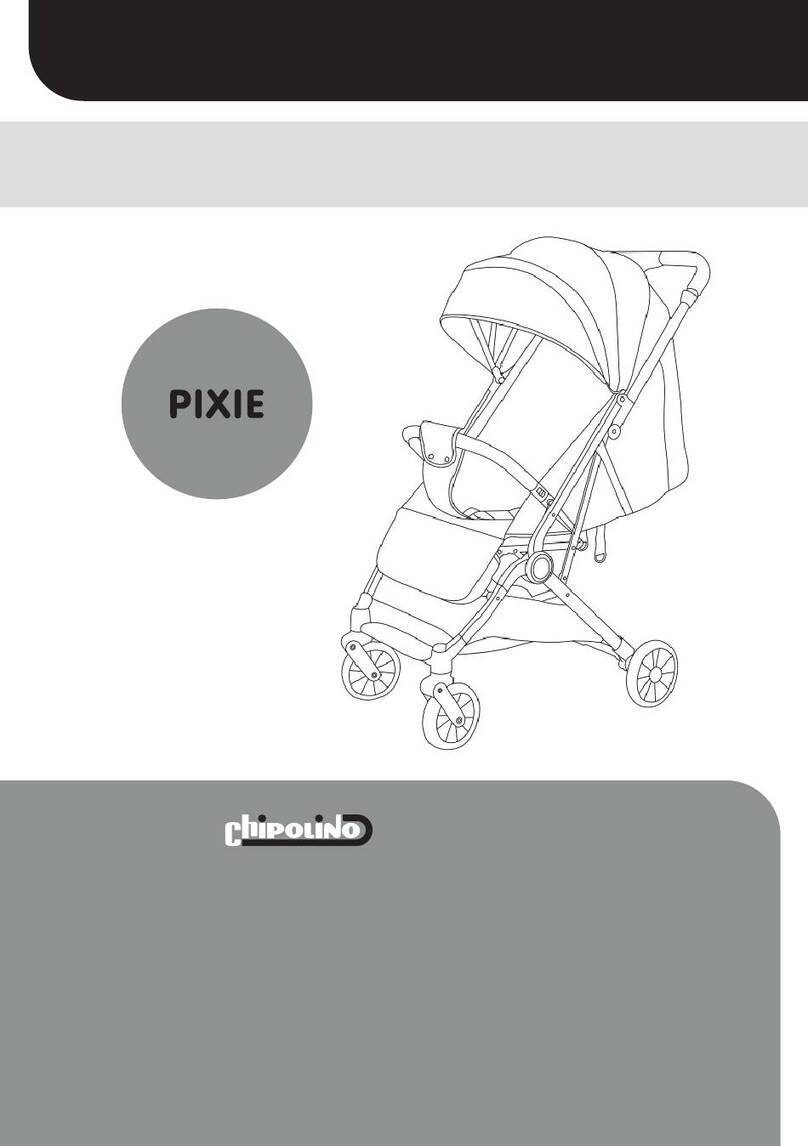
Chipolino
Chipolino "PIXIE L instruction manual

Tutti Bambini
Tutti Bambini ARLO Assembly & instruction manual
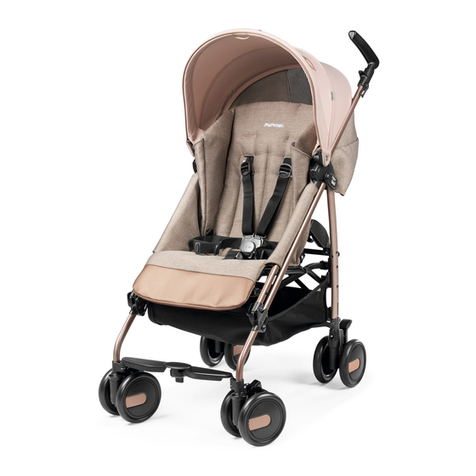
Peg-Perego
Peg-Perego Pliko Mini Instructions for use

RED CASTLE
RED CASTLE SHOP N JOGG DISC II Instructions for use

Emmaljunga
Emmaljunga nxt90 instruction manual
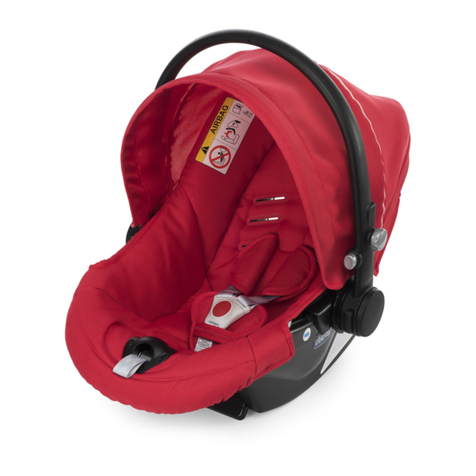
Chicco
Chicco synthesis Instructions for use
